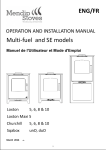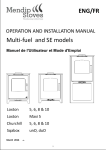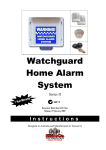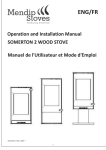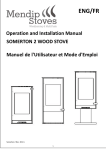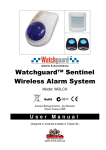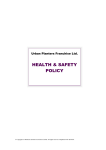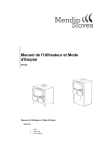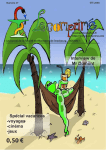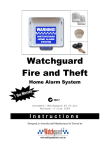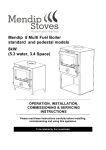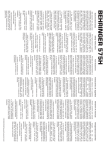Download Mendip Loxton 6 Installation manual
Transcript
OPERATION AND INSTALLATION MANUAL
Multi-fuel and SE models
Loxton 3, 5, 6, 8 & 10
Churchill 5, 6, 8 & 10
Sqabox unO, duO
1
Installation Manual and Operating instructions
LOXTON 3kW
LOXTON 5 kW, LOXTON 6 kW, LOXTON 6 PEDESTAL
LOXTON 8 kW LOXTON 8 PEDESTAL
LOXTON 10kW LOXTON 10 PEDESTAL
CHURCHILL 5 kW, CHURCHILL 6 kW, CHURCHILL 6 PEDESTAL
CHURCHILL 8 kW CHURCHILL 8 PEDESTAL
CHURCHILL 10 kW CHURCHILL 10 PEDESTAL
CHURCHILL 6 kW convection, CHURCHILL 6 PEDESTAL convection
CHURCHILL 8 kW convection, CHURCHILL 8 PEDESTAL convection
CHURCHILL 10 kW convection, CHURCHILL 10 PEDESTAL convection
SQABOX unO
SQABOX duO
TM
TM
This manual refers to the stoves listed above, which are tested in accordance with EN 13240.
Congratulations on your purchase of a new stove from Mendip Stoves. Please read this manual carefully to ensure that you
get maximum enjoyment from your new stove and to prevent any problems. Please note that “all local regulations, including
those referring to national and European Standards, need to be complied with when installing this appliance”.
For further information on installing and using fireplaces and wood burning stoves, please see the relevant building
regulations that apply to the country in which Loxton ,Churchill and Sqabox have been approved, as well as the relevant
brochure on the correct use of wood burning stoves available from your local stove supplier or your Chimney sweep.
These instructions cover the basic principals to ensure the satisfactory installation for Loxton/Churchill/Sqabox multi-fuel
stove, although detail may need slight modification to suit particular local site conditions.
Loxton 3
Loxton 5
Loxton 6
Loxton 8
Loxton 10
Loxton 6 pedestal
Loxton 8 pedestal
Loxton 10 pedestal
Height
525
606
606
660
660
960
1040
1040
Width
380
490
490
490
705
490
490
705
Depth
280
320
340
400
400
340
400
400
Churchill 5
Churchill 6
Churchill 8
Chuchill 10
Churchill 6 pedestal
Churchill 8 pedestal
Churchill 10 pedestal
Churchill 6 convection
Churchill 8 convection
Churchill 10 convection
Churchill 6 pedestal convection
Churchill 8 pedestal convection
Churchill 10 pedestal convection
606
606
660
660
960
1040
1040
606
660
660
960
1040
1040
490
490
490
705
490
490
705
575
575
790
575
575
790
380
400
460
460
400
460
460
400
460
460
400
460
460
71 kg
81 kg
91 kg
110 kg
91 kg
105 kg
125kg
88 kg
110g
118 kg
103kg
117kg
133kg
Sqabox unO
Sqabox duO
606
606
490
490
320
340
71 kg
81 kg
2
Depth with Lip plate
380
400
460
460
400
460
460
Weight
60 kg
71 kg
81 kg
91 kg
110kg
91 kg
105 kg
125 kg
HEALTH AND SAFETY PRECAUTIONS
—---------------------------------------------------------------------------------------------------INFORMATION FOR THE USER, INSTALLER AND SERVICE ENGINEER
—---------------------------------------------------------------------------------------------------Special care must be taken when installing the stove such that the requirements of the Health and Safety at Work Act are
met.
Handling
Adequate facilities must be available for loading, unloading and site handling.
Fire Cement
Some types of fire cement are caustic and should not be allowed to come into contact with the skin. In case of contact
wash immediately with plenty of water.
PREPARATORY WORK AND SAFETY CHECKS
IMPORTANT WARNING
This stove must not be installed into a chimney that serves any other heating appliance. There must not be an extractor
fan fitted in the same room as the stove because this can cause the stove to emit fumes into the room.
Asbestos
This stove contains no asbestos. If there is a possibility of disturbing any asbestos in the coarse of installation then please
seek specialist guidance and use appropriate protective equipment.
Metal Parts
When installing or servicing this stove care should be taken to avoid the possibility of personal injury.
CO Alarms:Building regulations require that when ever a new or replacement fixed solid fuel or wood/biomass appliance is installed
in a dwelling a carbon monoxide alarm must be fitted in the same room as the appliance. Further guidance on the
installation of the carbon monoxide alarm is available in BS EN 50292:2002 and from the alarm manufacturer’s
instructions. Provision of an alarm must not be considered a substitute for either installing the appliance correctly or
ensuring regular servicing and maintenance of the appliance and chimney system.
Stove paint Aerosols
Paint aerosols are flammable and therefore dangerous to use around a lit stove. Be sure to allow aerosols spray paints
to dry and ventilate the room well before lighting the stove. The use of any aerosol around lit stove is dangerous and
care must be take in handling aerosols.
These instructions cover the basic principles to ensure the satisfactory installation of the Mendip Stoves
Ltd :- Churchill , Loxton and Sqabox models, although detail may need slight modification to suit particular
local site conditions.
In all cases the installation must comply with current Building Regulations, Local Authority Byelaws and
other specifications or regulations as they affect the installation of the stove.
It should be noted that the Building Regulations requirements may be met by adopting the relevant
recommendations given in British Standards BS 8303, BS EN 15287 as an alternative means to achieve an
equivalent level of performance to that obtained following the guidance given in Approved Document J.
3
STOVE PERFORMANCE & TESTING
MENDIP STOVES Loxton & Churchill stoves are approved and tested in accordance with EN 13240.
Output
wood fuel
Loxton 3
Loxton 5
Loxton 6
Loxton 8
Loxton 10
Churchill 5
Churchill 6
Churchill 8
Churchill 10
Sqabox unO
Sqabox duO
3.2kw
4.6kw
6kw
8kw
10kw
4.6kw
6kw
8kw
10kw
4.6kw
6kw
Stove model
Weight &
Efficiency
CO@13%
o2
86.0%
80.0%
80.0%
80%
77.0%
80%
80%
80%
77.0%
80%
80%
0.25
0.29
0.29
0.16
0.29
0.29
0.29
0.16
0.29
0.29
0.29
Recommended
for smoke control
Oct 2012
Yes / SE model
Yes / SE model
Yes / SE model
Yes / SE model
NO
Yes / SE model
Yes / SE model
Yes / SE model
NO
Yes / SE model
Yes / SE model
Output coal
Efficiency
fuel
3.2kw
4.6kw
6kw
7kw
N/A
4.6kw
6kw
7kw
N/A
4.6kw
6kw
85%
78%
73%
73%
N/A
78%
73%
79%
N/A
78%
73%
CO@13% o2
0.12
0.15
0.15
0.06
N/A
0.15
0.15
0.06
N/A
0.15
0.15
Nominal heat output for Wood and Smokeless fuels
Log length
Wood reload
Weight wood load
Coal reload
Weight coal (anth)
Loxton 3
20cm
1hr
700 g
2hr
700 g
Loxton 5
35cm
1hr
1.2kg
2hr
1.4kg
Loxton 6
35cm
1hr
1.5kg
2hr
1.7kg
Loxton 8
35cm
1hr
2.25 kg
2hr
2.25kg
Loxton 10
60cm
1hr
2.4 kg
N/a
Churchill 5
35cm
1hr
1.2 kg
2hr
1.4kg
Churchill 6
35cm
1hr
1.5kg
2hr
1.7kg
Churchill 8
35cm
1hr
2.25 kg
2hr
2.25kg
Churchill 10
60cm
1hr
2.4 kg
N/a
Sqabox unO
35cm
1hr
1.2kg
2hr
1.4kg
Sqabox duO
35cm
1hr
1.5kg
2hr
1.7kg
Chimney Connection
In order for the stove to perform satisfactorily the chimney height must be sufficient to ensure an adequate draught to
clear the products of combustion and prevent smoke problems into the room.
Tested Gas flow rates flue
gas temperatures
Loxton 3
Loxton 5
Loxton 6
Loxton 8
Loxton 10
Churchill 5
Churchill 6
Churchill 8
Churchill 10
Sqabox unO
Sqabox duO
Flue gas flow rate
Wood /coal
2.6/2.5g/sec
4.3/4.7 g/sec
5.8/7.1 g/sec
5.8/7.1 g/sec
6.9g/sec
4.3/4.7 g/sec
4.3/4.7 g/sec
5.8/7.1 g/sec
6.9g/sec
4.3/4.7 g/sec
5.8/7.1 g/sec
Test flue gas temperature
wood /coal
173/215 deg C
231/221deg C
291/332deg C
291/332deg C
325deg C
231/221deg C
231/221deg C
291/332deg C
325deg C
231/221deg C
291/332deg C
@ pascals of pressure
12 pa
12 pa
12 pa
12 pa
12 pa
12 pa
12 pa
12 pa
12 pa
12 pa
12 pa
NOTE: A chimney height of not less than 4.5 metres measured vertically from the outlet of the stove to the top of the
chimney should be satisfactory. Alternately the calculation procedure given in BS 5854:1980 may be used as the basis for
deciding whether a particular chimney design will provide sufficient draught.
4
Flue and Chimney connection to your stove
The outlet from the chimney should be above the roof of the building in accordance with the provisions of Building Regulations
Approved Document J.
If installation is into an existing chimney then it must be sound and have no cracks or other faults which might allow fumes
into the house. Older properties, especially, may have chimney faults or the cross section may be too large i.e., more than
230 mm x 230 mm. Remedial action should be taken, if required, seeking expert advice. If it is found necessary to line the
chimney then a flue liner suitable for solid fuel must be used in accordance with Building Regulations Approved Document
J.
Any existing chimney must be clear of obstruction and have been swept clean immediately before installation of the stove.
If the stove is fitted in place of an open fire then the chimney should be swept one month after installation to clear any
soot falls which may have occurred due to the difference in combustion between the stove and the open fire.
SOOT DOOR WHEN
FIXED AGAINST
OUTSIDE WALL
If there is no existing chimney then either a prefabricated block chimney in accordance with Building Regulations Approved
Document J or a twin walled insulated stainless steel flue to BS 4543 can be used. These chimneys must be fitted in accordance
with the manufacturer’s instructions and Building Regulations.
A single wall metal flue pipe is suitable for connecting the stove to the chimney but is not suitable for using for the
complete chimney. The chimney and connecting flue pipe must have a minimum diameter of 150 mm and its dimension
should be not less than the size of the outlet socket of the stove. Any bend in the chimney or connecting flue pipe should
not exceed 45°. 90° bends should not be used other than within 150 mm of stove rear flue outlet.
5
Flue and Chimney connection to your stove (continued)
If it is found that there is excessive draught in the chimney then either an adjustable flue damper or alternately a draught
stabiliser should be fitted. The adjustable flue damper should not close off the flue entirely but should in its closed position
leave a minimum continuous opening free area of at least 20 % of the total cross sectional area of the flue or flue pipe.
Adequate provision e.g. easily accessible soot door or doors must be provided for sweeping the chimney and connecting flue
pipe
Your appliance needs to be maintained routinely, the throat plate/baffle should be cleaned regularly (monthly) . The flue
pipe can be cleaned using a flexible brush. Only Use a damp cloth on external surfaces. Over time the glass may become
dirty, clean with a damp cloth and polish off with damp cloth. If the stove has not been used for some time the flue should
be checked for blockages before use.
Do not modify the appliance; only use spares authorised by the manufacturer.
D
E
A
F
C
B
Loxton 3
Loxton 5
Loxton 6
Loxton 8
Loxton 10
Churchill 5
Churchill 6
Churchill 8
Churchill 10
Sqabox unO
Sqabox duO
A
525mm
606mm
606mm
660mm
660mm
606mm
606mm
660mm
660mm
606mm
606mm
B
380mm
490mm
490mm
490mm
705mm
490mm
490mm
490mm
705mm
490mm
490mm
C
280mm
320mm
340mm
400mm
400mm
380mm
400mm
460mm
460mm
320mm
340mm
D
125mm
125mm
125mm
150mm
150mm
125mm
125mm
150mm
150mm
125mm
125mm
6
E
107mm
115mm
115mm
115mm
110mm
115mm
115mm
115mm
110mm
110mm
110mm
F
400mm
480mm
480mm
530mm
530mm
480mm
480mm
530mm
530mm
480mm
480mm
F Ped
N/A
N/A
825mm
825mm
905mm
N/A
825mm
825mm
905mm
N/A
N/A
Distance to Combustible materials
Combustible materials should not be located where the heat dissipating through the walls of fireplaces or flues could
ignite it. Therefore when installing the stove in the presence of combustible materials due account must be taken of the
guidance on the separation of combustible material given in Building Regulations Approved Document J and also in these
stove instructions.
The minimum distances to flammable materials are specified on the EN 13240 plate on the back of the stove
480mm
Distance to
combustibles sides
Convection models
N/a
Suitable for 12mm
non-combustible floor
plate
YES
400mm
350mm
380mm
300mm
550mm
550mm
550mm
475mm
N/a
N/a
N/a
N/a
YES
YES
YES
YES
Churchill 5
Churchill 6
Churchill 8
400mm
350mm
550mm
550mm
380mm
550mm
N/a
350
400
YES
YES
YES
Churchill 10
300mm
475mm
300
YES
Sqarbox unO
400mm
550mm
N/a
YES
Sqarbox duO
350mm
550mm
N/a
YES
Distance to
combustibles rear
Distance to
combustbles sides
Loxton 3
770mm
Loxton 5
Loxton 6
Loxton 8
Loxton 10
Hearth
The hearth should be able to accommodate the weight of the stove and its chimney if the chimney is not independently
supported.
Churchill, Loxton and Sqabox stoves have been tested and are suitable to be installed on a 12 mm non combustible plate
such as 12 mm glass plates . Installation of all hearths should comply in size and construction so that it is in accordance
with the provisions of the current Building Regulations Approved Document J.
The clearance distances to combustible material beneath, surrounding or on the hearth and walls adjacent to the hearth
should comply with the guidance on the separation of combustible material given in Building Regulations Approved
Document J and also in these stove instructions.
If the stove is to be installed on a wooden floor, it must be covered with a non-combustible material at least 12 mm thick,
in accordance with Building Regulations Approved Document J, to a distance of 30 cm in front of the stove and 15 cm to
each side measuring from the door of the combustion chamber.
Combustion air supply
In order for the stove to perform efficiently and safely there should be an adequate air supply into the room in which the
stove is installed to provide combustion air. This is particularly necessary if the room is double-glazed or a flue draught
stabiliser is operating in the same room as the appliance. The provision of air supply to the stove must be in accordance
with current Building Regulations Approved Document J. An opening window is not appropriate for this purpose. Air inlets
must be positioned in such a way that they cannot be blocked. An air inlet may be a vent (the vent must be open and the
capacity for the vent sufficient when the stove is lit) .
There are no European rules regarding the minimum distance to non-flammable walls, Mendip Stoves recommend leaving
a gap of at least 10 cm behind and to sides of stove.
7
Mendip Stoves Insulated chambers
Mendip Stoves are lined with vermiculite heat deflection panels and baffles, these panels are designed to ensure the
maximum efficiency and are an integral part of the clean burn process of the stove. These baffles should not be removed
other than for cleaning the stove. Any defective panels should be replaced.
Place fuel into the fire fire chamber of your stove, impact from logs can cause the heat deflection panel to crack.
Connection to chimney
Mendip Stoves are factory set up with a top flue outlet, this can be altered from top to rear connection, remove the top
collar and rear cover plate and exchanging collar and plate. Care should be taken to ensure an airtight fit when refitting
collar and plate. A decorative cover plate is included with every stove to cover the hole in the convection top plate.
This collar allows connection to either a masonry chimney or a prefabricated factory made insulated metal chimney.
Commissioning and handover
Ensure loose parts are fitted in accordance with the instructions given in the instruction booklet. On completion of the
installation allow a suitable period of time for any fire cement and mortar to dry out, a small fire may be lit to check that
smoke and fumes are taken from the stove up the chimney and emitted safely into the atmosphere. Do not run at full
output for at least 24 hours.
On completion of the installation and commissioning ensure that the operating instructions for the stove are left with
the customer. Ensure to advise the customer on the correct use of the appliance with the fuels likely to be used in the
stove and notify them to use only the recommended fuels for the stove.
Advise the user what to do should smoke or fumes be emitted from the stove. The customer should be warned to use a
fireguard to BS 6539 in the presence of children, aged and/or infirm persons.
8
Operating your stove- Loxton, Churchill & Sqabox stove
Suitable fuels
Churchill , Loxton & Sqabox models are tested to burn wood or smokeless coal. (Loxton 10 & Churchill 10 are wood only)
Wood briquettes and peat can also be burnt. For a full list of suitable fuels, check with the official solid fuels approvals body,
HETAS or Solid Fuel Association. Do not overload stove as this can cause excessive heat and damage the stove( see table on
page 3 ). ALWAYS KEEP FUEL LOAD BELOW TERTIARY PORTS AT REAR OF STOVE.
Only use fuels approved for use on heating stoves.
Do not burn liquid fuels, drift wood, finished wood, sawn wood, pallet wood, chipboard/plywood ,varnished wood or
plastic coated wood, wood treated with preservatives, or house hold waste. DO NOT EXCEED SPECIFIED FUEL WEIGHTS.
DO NOT BURN HOUSE COAL. DO NOT BURN HOUSEHOLD WASTE, THIS APPLIANCE IS NOT AN INCINERATOR.
MENDIP STOVES RECOMMEND THE USE OF A FLUE THERMOSTAT TO CHECK YOUR STOVE IS NOT OVERHEATING. PLACE
FLUE THERMOSTAT DIRECTLY ABOVE COLLAR OF STOVE AND REFER TO TEMPERATURE GAUGE ON PAGE 4.
The first lighting of your stove.
Before lighting your stove for first time make sure you have read this manual fully and acquainted yourself with the
controls of this appliance. (see page 12)
The heat-resistant paint on your stove will cure and harden the first time you light your appliance. The curing process produces
a good deal of smoke and odour, it is therefore important that the first time you light your stove the room should be well
ventilated. During the process it is important to open and close the stove door periodically (every 30mins) during the first
couple of firings therefore preventing the door seal cord around the door from sticking and coming away from the door.
Once the heat-resistant paint has hardened the smell will disappear. This stove is NOT designed to be used with the door
open, the stove door must be kept closed except when lighting the stove, adding firewood or removing ash in order to
prevent flue gases from escaping.
Lighting your appliance
Quality Firelighters should be used when lighting the stove. (Never use metholated spirit, petrol or other flammable liquids).
Lighting your stove with firelighters will be more reliable and easier than using paper.
TO LIGHT YOUR STOVE(wood)
1. Place a few smaller pieces of dry wood (kindling) in the stove on top of the non toxic firelighters, place one or two small
dry split logs (¼ split) on top.
2. Fully slide open (to the left) the secondary air slider above the stove door. Slide to left fully the primary air slider below
the door of the stove. The stoves air controls are now fully open.
3. Light the firelighters and push door to closed position.
4. Once the flames from the logs are fully established slide to the right the primary air slider, this closes off the primary air.
5. If the stove begins to die when the primary is fully closed, open primary slider again until fire is established and then close.
6. Once established close the secondary air slider by 50%, for the stove to burn cleanly plenty of secondary air is needed, do
not be tempted to shut the fire down too early as this may cause smoke. At nominal heat output, expect to refuel your stove
approximately once an hour.
Check load weights for your model on the table on page 4.
The stove will get very hot during use and due care must therefore be exercised. Please use the glove and operating tool
supplied when operating air controls and door.
9
RE-FUELLING ( wood)
To re-fuel your stove in the cleanest way.
Only refuel your stove when flames have died down and you have glowing embers.
Before refuelling, open secondary air slider fully .
Open door gently, add two pieces of wood (see weight table page 3) and close the door.
Once the flames from the logs are fully established the secondary air supply can be adjusted to the desired setting .
BURNING WOOD IN A SMOKE CONTROL AREA
You must purchase a smoke control version of the Mendip stove which is modified slightly to comply with regulations. Any
change to this modification will invalidate the stoves compliance for smoke control areas.
The Clean Air Act 1993 and Smoke Control Areas
Under the Clean Air Act local authorities may declare the whole or part of the district of the authority to be a smoke
control area. It is an offence to emit smoke from a chimney of a building, from a furnace or from any fixed boiler if located
in a designated smoke control area. It is also an offence to acquire an "unauthorised fuel" for use within a smoke control
area unless it is used in an "exempt" appliance ("exempted" from the controls which generally apply in the smoke control
area).
The Secretary of State for Environment, Food and Rural Affairs has powers under the Act to authorise smokeless fuels or
exempt appliances for use in smoke control areas in England. In Scotland and Wales this power rests with Ministers in the
devolved administrations for those countries. Separate legislation, the Clean Air (Northern Ireland) Order 1981, applies in
Northern Ireland. Therefore it is a requirement that fuels burnt or obtained for use in smoke control areas have been
"authorised" in Regulations and that appliances used to burn solid fuel in those areas (other than "authorised" fuels) have
been exempted by an Order made and signed by the Secretary of State or Minister in the devolved administrations.
Further information on the requirements of the Clean Air Act can be found here: http://smokecontrol.defra.gov.uk/ Your
local authority is responsible for implementing the Clean Air Act 1993 including designation and supervision of smoke
control areas and you can contact them for details of Clean Air Act requirements
Using your stove in a smoke control zone.
Only specific SE models are suitable for smoke control areas (see page 4), alterations should not be attempted.
Mendip smoke control stoves should not be burnt with the door left open.
The refuelling procedure : - allow the newly charged fuel to burn with the secondary air control set at maximum for up 3
to 4 minutes. After this period, with flames from the logs fully established, close the secondary air supply to the low
output setting. When operating at high output (secondary air set fully open) the new refuel charge does not require any
boost air to establish combustion.
Refuelling on to a low fire bed
If there is insufficient burning material in the firebed to light a new fuel charge, excessive smoke emission can occur.
Refuelling must be carried out onto a sufficient quantity of glowing embers and ash that the new fuel charge will ignite in
a reasonable period. If there are too few embers in the fire bed, add suitable kindling to prevent excessive smoke
Dampers left open
Operation with the air controls or appliance dampers open can cause excess smoke. The appliance must not be operated
with air controls, appliance dampers or door left open except as directed in the instructions.
TO LIGHT YOUR STOVE (Solid Fuel)
Note: on cold days it maybe necessary to warm the flue using two firelighters.
1. Place Firelighters and a few smaller pieces of dry wood (kindling) among a small quantity of fuel in the combustion
chamber.
2. Fully slide open (to the left) the secondary air slider above stove door on right hand side. Slide to left fully the primary
air slider below door of stove. The stove’s air controls are now fully open. Light firelighters and securely close door.
3. With the fire established, open the door. And fill chamber with fuel, (see weight table on page 3) do not overload. (do
not cover tertiary air ports). Reloading is approximately every 2 hours.
4. Close fire door, set primary air to 45% open and set secondary air to 40% open.
5. Adjust as necessary.
The stove is only suitable for intermittent use only: do not run overnight or for long periods unattended. Experience will
determine the settings that produce best results. Use a flue thermostat to check the stove is not overheating. Flue
thermostats should be placed directly above collar of the stove on a non insulated section of pipe. (efficient operating
temperature range is between 100c and 200c) The stove will get very hot during use and due care must therefore be
exercised. Please use the glove and operating tool supplied when operating air controls and door.
10
RE-FUELLING (Solid fuel)
To re-fuel your stove.
Before refuelling, open secondary and primary air controls fully.
Open door gently and de -ash your stove with use of poker. (not provided)
Add fuel to below tertiary air bar (see weight table on page 3) and close the door.
Leave the air controls open whilst fuel is established.
Set primary air to 45% open and set secondary air to 40% open.
In the event of a chimney fire: Close the air controls and the stove door, and call 999 or your local fire brigade.
If your stove is overheating close all air sliders and door , leave until the stove has returned to normal temperature.
Incomplete combustion
If the air controls on your Churchill, Loxton or Sqarbox stove are closed too much incomplete combustion may lead to a
build-up of hard, shiny soot on the inside of your stove and glass. To prevent sooting of the chamber and glass introduce:1) more secondary air,
2) check that your fuel is suitable and dry.
3) that you have sufficient draw in your chimney.
It is important to check the draft conditions before lighting your stove. This may be done, for instance, by crumpling a
piece of newspaper, placing it in the combustion chamber and lighting it. The draft conditions are good if the smoke is
drawn away through the chimney.
WOOD FUEL
Good quality wood is the most important factor in your stove working efficiently and cleanly. Always use dry split
hardwood firewood (moisture content of 20% or less). The dryness of the firewood plays an important role since the use
of wet wood results in poor fuel economy and may cause a tarry sooty film on the internals of the stove.
Newly cut wood contains 60–70% water, making it totally unsuitable for use as firewood.
Newly cut wood should be stacked and air dried under cover for two years before being used as firewood.
Do not burn liquid fuels, drift wood, finished, sawn wood, pallet wood, chipboard/plywood, varnished wood or plastic
coated wood, wood treated with preservatives, or house hold waste.
SOLID SMOKELESS FUELSLoxton, Churchill & Sqabox models are suitable for use with good quality smokeless fuels and have been fully tested to the
relevant European standard. Only use registered smokeless fuels on this stove. Take special note of load quantities in
front of this book.(page 4)
HOUSE COAL AND PETROLEUM COKE ARE NOT SUITABLE FOR USE ON THIS STOVE; ITS USE WILL INVALIDATE THE
GUARANTEE.
Overnight burning
Mendip stoves ltd do not recommend burning coal in a slumbering position, Mendip stoves are designed to burn wood
and quality registered smokeless fuels.
Wood burns more efficiently and cleanly if it is burnt hotter. Mendip stoves do not recommend that their stoves are burnt
overnight for this reason.
As a night time regime we recommend that the fire is loaded when hot and burnt for five minutes with the secondary air
control fully open until the new wood has taken and is burning, then close the secondary air valve to its operational
position.
On returning to the stove in the morning the fire will have burn out, reload with some paper or firelighter and some
kindling and open both air sliders fully to relight quickly. Beware as the ash bed will have hot embers.
Permanent air vent
The stove requires a permanent air vent to the room . This is to provide adequate air supply in order for the stove to
operate safely and efficiently. In accordance with current Building Regulations the installer may have fitted a permanent
air supply vent into the room in which the stove is installed to provide combustion air. This air vent should not under any
circumstances be shut off or sealed.
11
AIR CONTROLS
Secondary air
Left open / right closed
Tertiary air
Permanently open
Primary air
Left open / right closed
DOOR OPERATION
When opening the door of your Mendip
stove always wear the glove that is
provided to protect your hand from
possible heat.
The handle has push pull motion as shown
above. When shutting the door push the
door closed and push handle firmly until
the door latches.
To Open door lift handle.
To close push door closed and
push handle down until located
PARTS
Always use the operating tools provided when handling parts likely to be hot when the stove is in use.
The Loxton ,Churchill & Sqabox stoves have the following tools and parts packed in the stove
1) 5mm steel wood grate plate - for use when burning wood only (remove when burning coal)
2) Ash tray removal tool
3) Stove Glove
4) Instruction manual
5) Ash Pan
12
Maintenance
Mendip stoves recommends that the Churchill, Loxton & Sqabox models need to have the ash removed from the stove at
regular intervals (weekly if used daily). Allowing the ash pan to over flow can impede the function of the stove and can
cause possible damage to the stove grate and ash pan. To remove ash pan use ash pan tool to hook under frontal loop on
front of ash pan drawer. Lift and pull out of firebox chamber. Take care to support ash pan during movement, always
wear a heat resistant glove. Make sure the stove is completely cold before cleaning out ash (embers can remain hot for
over 24 hours).
Ash must be stored in a non-combustible container and must not be mixed with other combustible waste.
Prolonged non use (summer)
If the stove is to be left unused for a prolonged period of time (e.g. over the summer) then it should be given a thorough
clean to remove ash and unburned fuel residues. To enable a good flow of air through the appliance to reduce
condensation and subsequent damage, leave the air controls fully open.
It is important that the flue connection, any appliance baffles or throat plates and the chimney are swept prior to lighting up
after a prolonged shutdown period.
Annual service
The inside of the stove should be serviced /cleaned once a year. To clean the inside, remove all ash, soot and tar residue
from the combustion chamber. Remove insulated chamber panels and baffle, dirt and soot will collect behind it and this
must be cleaned out. Check the quality of all insulated panels and replace any which are damaged or cracked, replace
stove door rope cord in the door. Check glass is correctly positioned.
The stove, the flue pipe connection and the chimney should be checked regularly by a qualified engineer. The chimney
should also be checked for blockages before relighting the stove if it has not been used for an extended period of time.
The paint/ lacquer can wear thin in exposed places due to overheating. This, and other lacquer damage, may be repaired
using Senotherm paint/lacquer spray available from your Mendip dealer.
To clean the outside of the stove use a dry cloth.
Warning Note
Properly installed, operated and maintained this stove will not emit fumes into the dwelling. Occasional fumes from
de-ashing and re-fuelling may occur. However, persistent fume emission is potentially dangerous and must not be tolerated. If fume emission does persist, then the following immediate action should be taken:(a)
(b)
(c)
(d)
Open doors and windows to ventilate the room and then leave the premises.
Let the fire go out.
Check for flue or chimney blockage and clean if required
Do not attempt to relight the fire until the cause of the fume emission has been identified and corrected. If necessary
seek expert advice.
The most common cause of fume emission is flueway or chimney blockage. For your own safety these must be kept clean
at all times.
CO Alarm
Your installer should have fitted a CO alarm in the same room as the appliance. If the alarm sounds unexpectedly, follow
the instructions given under “Warning Note” above.
13
Trouble shooting
1.
a)
b)
c)
d)
e)
Fire Will Not Burn - check
the air inlet is not obstructed in any way,
that chimney and flue ways are clear,
that a suitable fuel is being used,
that there is an adequate air supply into the room,
that an extractor fan is not fitted in the same room as the fire.
2. Fire Blazing Out Of Control - check
a) the doors are tightly closed,
b) the air controls are turned down to the minimum setting,
c) the flue damper is closed ( if fitted),
d) a suitable fuel is being used,
e) the door seals are in good condition.
f) the chimney draft may be too strong
g) check ash pan seal and
h) check for ash below ash pan causing pan to seat incorrectly and clean out.
3) Soot forms on the window
a) The firewood may be too wet
b) the intake of secondary air may be insufficient
c) fire not hot enough
4) The stove fails to heat fully
a) The firewood may be too wet
b) the intake of secondary air may be insufficient
5) Smoke or odour
a) Weak chimney draft
b) check for blockages in the flue pipe/chimney
c) check the height of the chimney relative to the surroundings
6) Soot in the chimney
a) The firewood may be too wet
b) intake of secondary air may be insufficient
Chimney Fires
If the chimney is thoroughly and regularly swept, chimney fires should not occur. However, if a chimney fire does occur
turn the air control setting to the minimum, and tightly close the doors of the stove. This should cause the chimney fire to
go out in which case the control should be kept at the minimum setting until the fire in the stove has gone out. The
chimney and flue ways should then be cleaned. If the chimney fire does not go out when the above action is taken then
the fire brigade should be called immediately.
After a chimney fire the chimney should be carefully examined for any damage. Expert advice should be sought if
necessary
14
15
Eurostove Ltd
Tel: 01934 750 500
Unit H1,
Fax: 01173 156 207
Mendip Industrial Estate,
www. Mendipstoves.co.uk
Mendip Road, Rooksbridge, Somerset
E-mail : [email protected]
BS26 2UG
Mendip Stoves Ltd, 2012, ver 3, July 2012
16
















